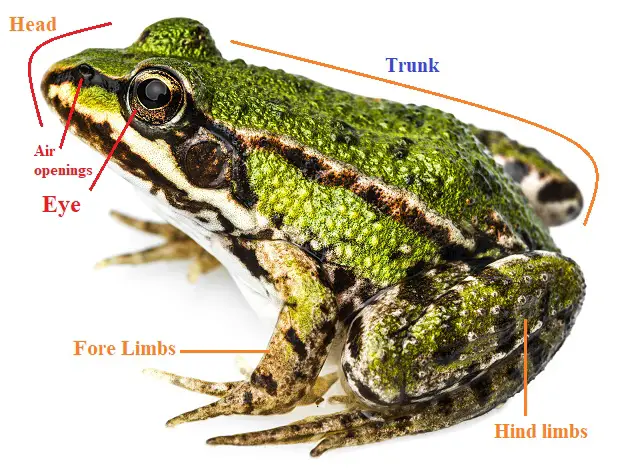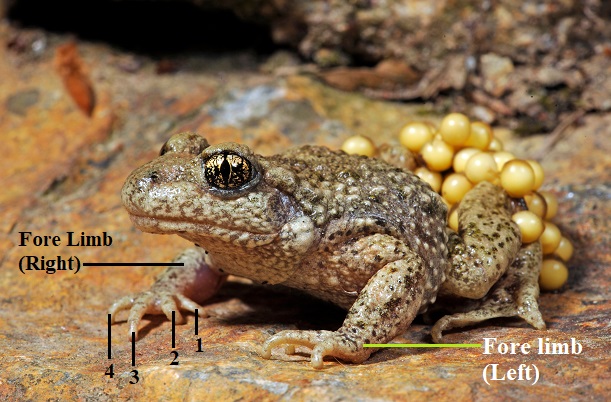Frogs are amphibians found near water and damp places.
The commonly found frog in the world belongs to the genus “Rana.”
These animals prefer to stay in water or near water to
- Keep their skin moist for cutaneous respiration
- To quickly jump and slip into the water and escape from their enemies.
Frog External Anatomy
In the frog picture below, notice the labeled external anatomical parts

Shape and Size
- The size of an average frog is around 12 to 18 cm in length and 5 to 8 cm in width.
- Its body is slightly spindle-shaped, rounded posteriorly, and pointed anteriorly.
- Sometimes, the body is slightly flattened dorsoventrally and streamlined to swim through the water.
- The frog’s body can be divided into a head, trunk, and limbs with no neck and tail.
- However, the frog has a tail at birth, which disappears as the baby frog transforms by metamorphosis.
Skin and Color
- In general, the frog’s skin is thin, slimy, and moist for the process of cutaneous respiration.
- The skin is loosely fitted to the body of the frog, which remains like loose skin layers.
- The back part of the frog skin has dorsolateral folds and thickenings, called dermal plicae.
- It is seen generally, that the color of the frog’s skin is mainly green with black and yellow spots over it.
- In some cases, brown spots are also found in the central part.
- A light yellow mid-dorsal line is seen on the body of the frog which runs from the tip to the snout to the cloacal opening at the back of the body.
- Change in color of the skin is also seen in frogs due to the expansion of melanophores pigment.
Head
- The head of the frog is somewhat demarcated clearly from the trunk region.
- The region is a flat, and rough triangle in outline and with a blunt anterior snout that terminates in a wide transverse mouth.
- Two small openings are found on the head region which lies dorsally above the mouth tip of the snout that serve in respiration.
- In the head region, the two protruding eyes are situated dorsolateral to each other on the top.
- When the eyes are pressed downwards, they make an imminent presence in the buccal cavity.
- Each eye has a thick and pigmented, immovable lower eyelid.
- From this place arises a thin, semi-transparent eyelid called a nictitating membrane.
- This membrane covers the eye and protects during swimming and it keeps the eye moist all the time.
- Behind each of the eyes, there is the presence of a pigmented circular patch of skin called the eardrum or tympanum.
- This is responsible for receiving the sound waves for hearing.
Trunk
- The head is broadly connected with a flat, ovoid-shaped trunk (the body).
- Its back part is raised in the middle region in a characteristic sacral prominence of the hump.
- This hump is especially conspicuous when the frog starts to squat.
- The trunk region encases the lungs, heart, digestive tract, liver, genitals, and kidneys.
- At the posterior end of the frog’s trunk, there is a small aperture called the cloacal aperture.
- This aperture is the opening that facilitates the disposal of feces, urine, and reproductive gametes like the sperms and ova.
Limbs
- Laterally, the trunk of the frog has two pairs of limbs.
- The short limbs arise from the anterior part of the trunk, from just behind the head, while the hind limbs arise from the posterior of the trunk.
Each of the forelimbs show the following parts.
- The upper arm called Brachium
- Forearm called Antebrachium
- Wrist called Carpus
- Hand called Manus
- The hand or manus bears 4 digits (fingers) without webbing.

- Of these 4 digits, the thumb or pollex is vestigial.
- In the case of a male frog, the base of the first finger is thickened, forming the nuptial pad in breeding seasons that helps clasp the female amplexus.
The hind limbs are powerful and arise from the trunk region.
Each of the hind limbs consists of:
- The thigh
- Shank called crus
- Ankle called tarsus
- Large foot called pes (distal portion of the hind limb)
These hind limbs support swimming and walking on damp lands.
Sexual Dimorphism
Sexual dimorphism is strongly seen in the frog population.
Several imminent identifying features help in distinguishing male and female frogs, which are as follows:
- The males are smaller than the females and have darker shades than the males.
- Male frogs are slimmer, whereas female frogs are stouter when they carry eggs.
- The male frogs croak louder.
- The female frogs lack the eardrum present in males.
- The male frogs have swollen copulatory and nuptial pads on the inner fingers, which are lacking in female frogs.